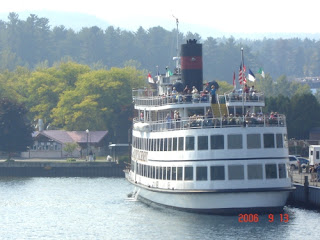 |
| View from the convention center |
Brief technical summaries of some talks that might interest folks
I know:
1) X-ray
crystallography generally requires monochromatic, spatially coherent beams to
determine crystal structure through diffraction patterns. It is difficult to
produce such perfectly coherent beams. Emil Wolf, University of Rochester, gave
a single author talk on a general formula which gives the effect of spatial
degree of coherence of incident radiation on the diffraction pattern in X-ray
crystallography. This enables the use of partially spatially coherent light in
X-ray crystallography.
If there was a
single most inspiring moment at FiO 2012, seeing a nonagenarian scientist stand
up and deliver that talk was it!
2) Sam
Thurman gave a very interesting talk where he performed digital refocusing,
aberration correction, and image stitching for coherent image fields. He used
the sharpness metric. I can’t find an actual paper submission on this work, but
I’ll link it in future.
3) Hu and Hua from Arizona spoke about the design of a see-through, stereo,
multi-focal plane display containing freeform optics. Stereo imaging systems
give decent stereo effect, but suffer from accommodation-vergence conflict. Various
methods can be used to overcome this issue:
i)
Spatial multiplexed methods which use beam
splitters (Akeley, 2004) or stacked displays (Rolland 2000)
ii)
Time multiplexed systems which use liquid crystral
lenses (Suyama 2008??), deformable mirrors (McQuaide 2003), liquid lenses (Liu
2008) and birefringent lenses (Love 2009).
Suyama 2008
discussed a depth fused 3D perception mechanism which proposed adding up a
weighted proportion of the content at different display planes to provide
appropriate stereo perception. Liu et al discussed a display using this
mechanism in Opt Express 2010.
The current talk
focused on making a see-through display where they used a double telecentric
image relay and designed a prism shaped eye-piece with freeform surfaces and a
compensator which allows for viewing real-world objects in transmission. I think this 3D information display related work is very cool.
4) Qin, Zheng and Hua presented a new design for an endoscope which simultaneously
provides high resolution, high magnification and wide field of view. This is
useful to avoid moving the laproscope for a better view during a procedure.
They developed a multi-foveated laproscope
with a built-in scan lens that changes the angle of view and zooms in on
a specific portion of the object.
5) Yonina Eldar’s group has a few interesting papers at FiO. The team showed data from an
FTIR interferometer, where they tried to obtain higher resolution spectral
output than conventionally permitted by the limited travel range of FTIR
systems.
They used
sparseness and prior information about the shape and spacing of typical
spectral lines, and approximated them sparsely using a known basis. They used
these bases, and search for the extrapolated reconstruction that yields the
sparsest spectrum in the known basis. They also showed some data where they
found bases which represent the low resolution spectrum sparsely and then use
those bases for the reconstruction. They choose the extrapolated reconstruction
which still remains most compactly represented. If this method works as well as
they showed, this should allow for much cheaper FTIR spectrometers output much
finer spectra.
Another paper
from Eldar’s group showed super-resolution beyond the passband of the imaging
system for a 4-f system using similar compressed sensing based reconstructions.
I like this compressed sensing type work. ;)
6) Ori Katz spoke about imaging through scattering, turbid or random media. They treat
walls or tissue as scattering surfaces which generate speckle when light is
incident on them. The reflected light is passed via an SLM which corrects the
wavefront. The phase of light changes as it passes through turbulence or through a turbid
medium. The authors sense the wavefront aberrations and correct them with an
SLM in the light beam so that after passing through the turbid medium it
focuses at the other end to form an image. They discussed results with an incoherent
lamp source and used the local spatial invariance around an isoplanatic patch
to speed up their optimization algorithm (genetic). Ex: Imaging inside an egg.
7) Measuring
diffusion properties of fluids: Can be done using single molecule tracking with
light microscopy which has good spatial resolution, but low depth penetration.
Light scattering techniques like dynamic light scattering (DLS) and diffusing
wave spectroscopy (DWS) give ensemble average responses, but low local
resolution. Optical Coherence Tomography (OCT) is based on light scattering,
has better penetration and can provide local viscoelasticity properties of
complex fluids. Raghav Chhetri showed some results for the elastic and viscous
modulus of polyethelene glycol, from using optical coherence microrheology
(OCMR) to resolve diffusion of spherical and rod shaped probes in complex
fluids.
8) David Nolte from Purdue spoke about using cell and
tissue motion as a contrast agent for dynamic light scattering. They use
low-coherence digital holography as a coherence gate to select light from
specific depths in the tissue.
Light scatters
when incident on a complex, moving object. The fluctuations of the reflected
intensity depend on the nature of the motion, such as fast or slow. The
selection of specific depth layers in the object is done with Digital
holography. Digital holography performed in an off-axis configuration can be
used to create spatial interference and allows image reconstruction with a
quick fourier transform.
David showed
fluctuation spectrograms used for evaluating the effects of drugs on cells
comparing the results before and after. This technique would be very useful for
such drug evaluation applications and others.
9) Dan Marks: The gigapixel camera contains a central monocentric objective lens and
several micro-camera systems that enable gigapixel, wide field of view imaging.
Larger FsOV require different objectives and more microcameras. Dan discussed
scalable, economic design of microcameras which can be reused between different
camera designs having different FsOV. This saves them from having to make new
microcameras for every new mono-objective.


















